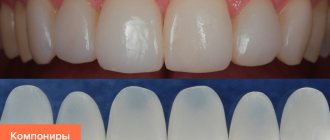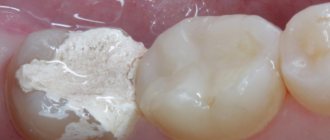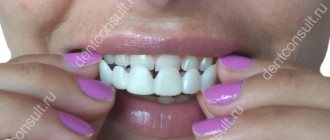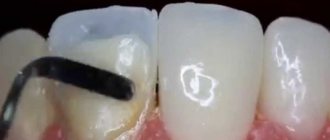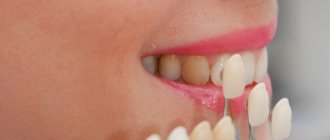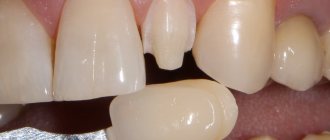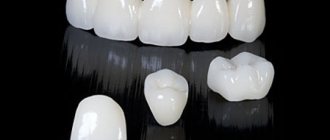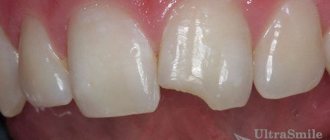Metal-ceramic crown
Modern materials used to make crowns are extremely durable and resistant to dyes. They are quite smooth and non-porous, so pigments cannot penetrate their structure. This is what allows you to limit yourself to daily oral hygiene using a toothbrush and regular paste.
If the material does darken, it is unlikely to be bleached. Metal-ceramics is a very hard and dense material in its structure; none of the modern brightening agents is able to penetrate inside it. In this case, it is possible to talk only about slight lightening, but not about whitening by several tones.
If the crowns are located on the side of the chewing teeth, then nothing will hinder the whitening of the smile area. Moreover, even a strong difference in shades will not affect the patient’s appearance in any way, because others simply will not notice it.
Is it possible to whiten teeth at home?
To maintain the natural whiteness of your teeth, it is important to brush them twice a day with a properly selected brush and toothpaste, rinse your mouth after every meal, use floss and antibacterial rinses, give up cigarettes and coffee, and undergo a professional procedure. hygiene every six months.
But if you naturally have a slightly yellowish or grayish tint to your enamel, even following all of the above measures will not be able to ensure an impeccably white smile. To do this you will have to resort to bleaching. This can be done at home in several ways:
- pencil - brightening gel is produced in a special tube, at the end of which there is usually a soft brush, brush or sponge for convenient application of the composition to the enamel surface. You must use the whitening pencil strictly according to the instructions. Typically, the gel is applied twice in the morning and evening for 2 weeks.
- strips and aligners - the gel can be immediately applied to the strips, which should be glued to the outside of the teeth for a certain time. Other systems include special mouth guards. Their inner surface must be independently coated with a lightening composition and then put on the dentition,
- abrasive pastes - they usually contain coarse abrasive particles, due to which the whitening effect is achieved. However, you cannot use them on an ongoing basis, otherwise you can damage the enamel, which will lead to its weakening and increased sensitivity - the development of hyperesthesia.
When whitening at home, a tray with a special gel is often used.
Before trying any of the methods described above, you should definitely consult a doctor. The specialist will conduct a visual inspection and determine the current condition of the enamel, and give his recommendations on choosing the appropriate system. If the enamel is weakened, thinned or too sensitive, the use of whitening strips and abrasive pastes is strictly contraindicated.
Ultrasonic cleaning of the oral cavity and results
You can lighten artificial dentures a little and restore the attractiveness of your smile with the help of professional cleaning. The whole point of this method is to eliminate plaque, tartar, food particles and deposits that have accumulated on the surface. Currently, specialists use a variety of methods for processing enamel; ultrasonic scalers are in great demand.
This method involves the use of a special device through the tip of which ultrasound and microvibrations are applied. They are capable of destroying even the hardest plaque in just a few seconds without much effort. Simultaneously with ultrasound, the device delivers a stream of water, due to which the enamel is protected from overheating, and crushed particles of contaminants are washed out from its surface.
Dental clinic specialists strongly recommend cleaning your mouth at least once every six months; this will protect the enamel from the accumulation of hard stone and preserve the health of your teeth for a long time. However, this procedure is also ineffective in whitening fillings and crowns.
Care instructions
Despite the fact that metal-ceramic teeth do not require special care, they must be cleaned daily and thoroughly, this is the only way to be sure of a long service life of the prosthesis without unpleasant surprises. Simple but effective recommendations for caring for dentures:
- crowns must be cleaned using vertical sweeping movements from the gums to the cutting edge,
- choose a brush with soft bristles so as not to injure the mucous membrane. It is recommended to use an irrigator.
- if most of the series are dentures, give preference to toothpastes with plant extracts that care for gums,
- be sure to use dental floss to clean the interdental spaces where a lot of plaque accumulates,
- It is advisable to use disinfectant rinses,
- Smokers and coffee lovers should definitely have their teeth professionally cleaned by a dentist, as nicotine and caffeine leave a permanent plaque on teeth and crowns. Whitening pastes will not affect crowns in any way; you should not purchase them.
If possible, buy an irrigator. This is a special device that creates a thin stream of water under high pressure, washing away plaque and food debris from the most inaccessible areas. The irrigator also provides effective massage of the gums, cleanses the tongue and mucous membranes.
Installation of veneers and lumineers
As mentioned earlier, ceramic and plastic crowns are practically not amenable to any of the modern methods of whitening; they can only be cleaned of dirt accumulated on the surface. That is why many patients prefer using more advanced methods of dental restoration, for example, installing veneers.
Veneers are invisible overlays on the frontal area of the teeth, which are fixed using a special dental glue. With their help, you can easily disguise small chips, cracks, darkening of the enamel, as well as slight curvature and even gaps between teeth. These linings are made from very durable and resistant to external influences materials.
An even more reliable and aesthetically attractive option is lumineers. These are exactly the same pads, but thinner. Thanks to this, pre-grinding of the units is not required. Each of these prosthetic options involves taking impressions of the jaw, on the basis of which the onlays themselves are subsequently made. Quite often, doctors prefer to install veneers directly, that is, using a composite material and directly in the patient’s mouth.
Teeth whitening with crowns are the 2 easiest options.
There are two seemingly options you can consider if whitening your natural teeth is a real concern due to the presence of crowns or veneers.
- If the number of crowns is small, for example, on 2-3 front teeth, you can always evaluate the color of the teeth again and redo the crowns in accordance with the new light color of natural teeth. In this case, you should wait 2-4 weeks after whitening for your teeth to acquire a new lighter natural color.
- Switching to dental veneering – this method eliminates the constant need to whiten natural teeth. This method may be an ideal solution when the “neighborhood” of natural and cosmetic teeth does not allow the whitening procedure. The dental veneering procedure allows you to “whiten” your teeth forever and have the desired snow-white smile without the risk of yellowing.
The best method that's right for you should be discussed with your dentist, as they will know best how your teeth may respond to whitening with crowns or veneers. The dentist will suggest which solution will be the most profitable and long-term in order to achieve the cosmetic aesthetics of your smile.
Prevention
To ensure that fillings and crowns do not change their color or lose their attractiveness over time, it is very important to properly care for them. Care involves daily oral hygiene (morning, evening, and after each meal). It is also very important to remember to visit your dentist regularly for checkups.
In addition to the timely detection of enamel and gum diseases, the doctor can carry out preventive cleaning. If a patient has a bridge installed in their mouth, they should rinse the area between the crown and the gum tissue as often as possible. In this case, you can use a device such as an irrigator.
Other recommendations include abstaining from eating solid and coloring foods, strong coffee and black tea, red wine, quitting smoking and other bad habits. It is important to avoid strong temperature changes, as this can lead to loosening of the material and its darkening in the future.
previous post
Is it possible to treat teeth with stomatitis?
next entry
Whitening a pulpless tooth
Another obstacle to a perfectly white smile will be a pulpless tooth. Such teeth are essentially dead - during the treatment of pulpitis, the nerve is removed from them, and they are deprived of natural blood supply. Since nutrients also do not reach such teeth, dentin darkens over time - this is a natural process, and “dead” teeth, by definition, look darker than others.
Such teeth will also stand out from the general bleached row, unless intra-canal bleaching is performed. With this chemical whitening procedure, the reagent responsible for lightening the tooth will be applied not only outside, but also inside, into the cavity left after pulp removal. In this case, the filling that covered the tooth is removed, a temporary filling is placed during the course of procedures, and only after all whitening is completed, a new one is selected - a more suitable shade.
However, intracanal bleaching (as, in fact, chemical bleaching in general) is contraindicated in cases where:
- the patient has caries, pulpitis or periodontitis;
- the patient is allergic to hydrogen peroxide or has too sensitive enamel;
- The patient's age does not exceed 16 years.
It is important to know: intra-canal whitening cannot be performed on one tooth more than 3-4 times! When bleaching, the enamel is in any case subjected to serious chemical attack, and since the “dead” tooth is already weakened and is not restored by new nutrients, it can become too fragile and collapse.
How to whiten darkened teeth if you have crowns and other dentures
If, while wearing ceramic dentures, your teeth become darkened by plaque or tobacco, you can whiten them. To do this, the dentist will select the optimal method for the patient, based on the condition of the teeth - whether they are healthy, whether they have cracks or fillings. Whitening methods in the clinic and at home have already been discussed above. But if, for example, only the old filling has darkened, then it is worth replacing it - putting a new one in the desired shade.
Read on the topic: artistic restoration with a filling - how to make your smile more attractive in 1 visit to the clinic.
You can also cover your natural teeth with veneers or crowns (if they are severely damaged) in a color that perfectly matches the shade of the crowns, bridges or veneers already in your mouth.
How to properly clean metal-ceramic dental crowns
The popularity of metal-ceramic crowns is deserved.
They are durable, reliable and comfortable to use. The smooth surface of the products copes well with plaque. A beautiful snow-white smile that does not lose its tonal freshness over time is a huge plus. But everything needs care, even such durable technological designs. To the delight of metal-ceramic wearers, cleaning dental crowns of this type does not cause difficulties. It differs from caring for real teeth and also requires regularity. However, there are no difficulties, and no specific manipulations are required.
Cleaning cermets
Metal-ceramic crowns should be cleaned using the following recommendations:
- cleaning is performed with a regular toothbrush from the gums to the edges with vertical movements, trying to treat the space between the teeth as thoroughly as possible; It is recommended to choose a paste taking into account the needs of the gums rather than the teeth, since dental chemistry does not have a noticeable effect on metal-ceramics; It is best to use a herbal paste;
- the use of paste is complemented by cleaning the teeth with floss - it is necessary to make movements in all possible directions;
- After cleaning the dental crowns, rinse your mouth with water and a special product recommended by a specialist.
If you have a bridge, you need to very carefully wash the rinsing channel - the space between the gum and the artificial tooth. Food gets under a metal-ceramic crown only in the event of poor-quality work by the dentist. And it can easily get into the gap between the gum and tooth.
As a result of gum pliability and the penetration of pieces of food under it, the tissue becomes inflamed. It will no longer be possible to remove the foreign fragment without the intervention of a doctor. Symptoms will include discomfort and even pain, plus bad breath.
In order to prevent such incidents, when installing crowns, a flushing channel must be made. It makes it easier to remove food. To clean the gap, use miniature brushes, brushes, the same dental floss, and toothpicks.
Despite the smooth surface of the crowns, over time, plaque forms on them. Special means help fight it. If the case is advanced, you need to contact a dentist who will perform professional whitening of the products.
Recommendations for the use of metal ceramics
In addition to regular, proper cleaning of metal-ceramic structures, it is necessary to follow the rules for using crowns. Otherwise, despite the mastery of a toothbrush and mouthwash, the products will quickly become unusable.
Cleaning of metal-ceramic crowns should be supplemented with:
- ignoring the desire to chew hard objects with your teeth, such as nuts in the shell or a bottle cap; this does not benefit real teeth, and such actions bring outright harm to metal-ceramics;
- observing the temperature regime during meals - you cannot eat or drink either too hot or too cold foods; Moreover, it is forbidden to test crowns with thermal contrast - for example, eating ice cream and drinking hot tea;
- maintaining oral hygiene - using metal ceramics, it is not recommended to abuse coffee and tea, and even more so, smoking; otherwise, an unaesthetic plaque quickly appears on the products, which has to be removed in the dentist’s office;
- regular – at least twice a year – examination by a specialist; only a doctor can determine that the structures are being used properly.
Removable structures must be removed according to the dentist’s instructions - for example, placed in a container with a special liquid at night.
If you follow all the recommendations, the service life of metal-ceramic products is, on average, 7-8 years. An impressive period for which it is worth trying to take care of the condition of technological crowns.
